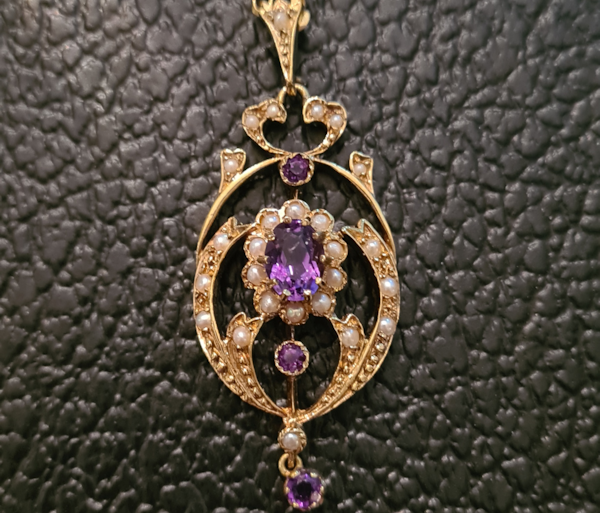
Shopping for sustainable jewellery
If you follow some antique jewellery dealers on Instagram, you’re likely to get tons of ads for “sustainable” jewellery. The reasoning behind the marketing seems to be that they use very little gold and synthetic stones (usually cubic zirconia) while also creating smaller batches in order to avoid surplus stock that goes to waste. However, there are two alternatives that are far superior to them when it comes to sustainable jewellery. The thing is:
Vintage and antique jewellery is sustainable jewellery
Yeah, there’s a reason why thrift shops have gotten so popular recently: sustainability. Buy second-hand and combine splurging and feeling good about yourself. And it’s great – even if a lot of people do it because influencers do it, rather than “for the right reason”, it saves clothes from landfills while also reducing the need for new material. This does of course also apply to the jewellery trade.
We all remember the concept of blood diamonds, and many of us have also heard about the supposedly conflict-free diamonds that you can buy without feeling bad about yourself. The problem is, where there is a potential for wealth, there are people who are willing to do ANYTHING to get to that wealth. The extraction of noble metals and gemstones is in most cases detrimental to the nature surrounding mines, the health of the people working in those mines and the quality of life of those who live in the area. If we can use what we’ve already pulled out from Mother Earth, we’re doing her a solid.
This is where pre-used or pre-loved jewellery comes into the picture. If you buy second-hand, your love of the sparklies is pretty much harmless. Having something wrapped and shipped, or even having it posted online (or in a shop that has to use electricity) will of course mean that buying old is worse than buying nothing at all, but in the big picture, you can shop antique jewellery with a clear conscience.
Jewellery made from old jewellery is pretty sustainable
Maybe you don’t like old stock. Maybe you know very well what you want, but ye olde fashions and your tastes don’t overlap all that much. In that case, going the route of new stock made from old stuff is a great solution.
You may find an artist that will either take your old gold and turn it into something made just for you, or a goldsmith or jeweller may have chosen to exclusively work with reclaimed stones and metal. There is also the alternative of getting a new piece of jewellery that includes parts of something old, like the BY MAYVEDA collection (not so much a fan of how they name their products, as some may be fooled into thinking that the pieces in their current form are genuine antiques, but I love the concept) or Hofer Antikschmuck’s workshop collection, which mainly consists of smaller pieces of old stock, like single stones or smaller parts of antiques set in new or reclaimed gold.
While these jewels will often be a bit less sustainable than just getting something old, it’s still a great solution. Old material is reused, and even if a new stone or a bit of new gold is added, it’s still better than buying something entirely new.
But how about those sustainability ads?
As you may have guessed, I’m not a fan, and it’s due to the three main selling points that I mentioned above.
Low grade gold, gold plated brass or some sort of gold-filled base metal has little inherent value – if any. 9 carat gold is still 1/3 gold, and will usually be quite resistant to wear and tear, so that’s good, but the low amount of gold also means that the value of the jewellery is quite limited. Low value and affordability has a tendency of making us buy more (just consider fast fashion clothing), and that’s not sustainable. Gold plated and gold filled jewellery may be pulled off as better than it is – like boasting about it being 18 carat gold filled, but the gold isn’t massive, and it will most likely be worn off in time. Regardless of what kind of gold alloy or adhesion method is used, the gold was stille extracted from a mine, and all the issues connected to mining still apply.
Synthetic stones are often presented as a great alternative to the real deal. Mo miners were harmed in the manufacturing process, after all. Granted, not everybody is able to buy an old diamond and have it attached to a modern ring made of old gold, but synthetic materials are still inherently worthless. The thing is, what makes diamonds have any value at all, is that it is moderately rare and made by nature. Even if the scarcity is in large degree created (that’s a subject for another day), the fact remains that there are limits to how many good quality diamonds of a certain size one has access to, while cubic zirconia (CZ) and other man-made diamond replacements can be created in whatever size, cut and clarity one may desire, and for a very low price. Thus, the combination of CZ and low-grade gold results in a piece of jewellery that has very little actual value, material wise. In addition, the main ingredient of CZ, zirconium, is a byproduct of mining other minerals, so while it’s not mined for its own sake, it’s still not a fully sustainable material.
Small batches can of course mean “less waste”, but don’t be fooled. This isn’t about avoiding waste, it’s about FOMO. If you see an ad, realise that there is a limited number of pieces available, and that you may never again get a chance to procure this delicate piece of gold-coated copper, you’re more likely to buy. No company is interested in limiting their income. Overstock is undesirable, so by making, say, 8 collections a year rather than 2, they reduce the risk of overstocking, sell maybe 3 or 4 pieces to every customer during the year, rather than 1, can manufacture pieces through the year rather than in two batches, and oh, they can claim that it’s all done for the environment. Nice!
So to sum it all up: I’m not going to tell you what to buy. Your wallet is your wallet, your ethics are your ethics and your style is your style. All I ask is that you don’t let the sustainability argument fool you. And if you feel bad about getting new jewellery because of the environmental impact, get something old! it doesn’t have to be that old – it could be something that was made last year, or a decade ago. Just shop for pre-owned pieces, and you’ll be able to splurge with a clear conscience.







-
-
3 years
Tagged gold